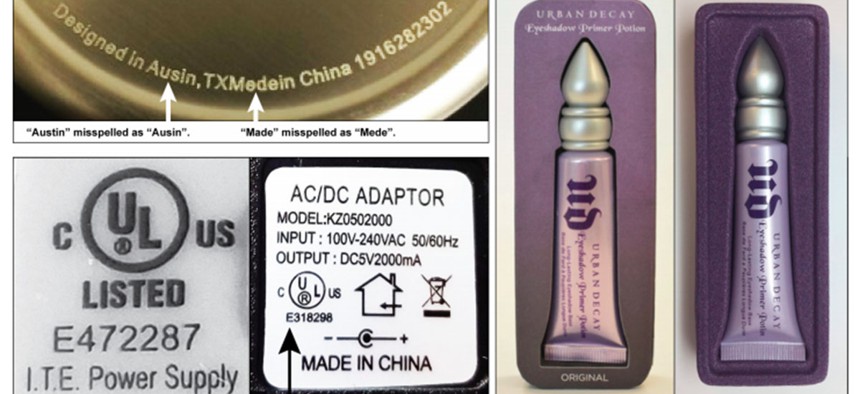U.S. Customs Needs To Share More Info on Counterfeits With Online Retailers

Examples of some counterfeit items purchased online and featured in a GAO report. GAO
Companies want Customs and Border Protection to do more, but officials say there’s only so much they can do.
Immigration and Customs Enforcement and Customs and Border Protection work together to stem the influx of counterfeit goods into the U.S., though the latter needs to better track its efforts and open new ways to work with the private sector, the Government Accountability Office warned in a new report.
The report—released March 6 in conjunction with GAO testimony before the Senate Finance Committee—noted the prevalence of fake consumer goods entering the country and the two agencies’ increased efforts to enforce U.S. intellectual property laws.
However, “while ICE has assessed some of its efforts, CBP has taken limited steps to do so,” GAO Director for International Affairs and Trade Kimberly Gianopoulos said in her written testimony. Similarly, while CBP has been empowered by Congress to work with the rights-holders by sharing pertinent information, “according to private sector representatives we spoke to, restrictions on the amount and type of information about seized items shared by CBP limit the ability of rights holders and e-commerce websites to protect” intellectual property, she said.
Counterfeit goods are as plentiful as ever. Data provided by CBP and ICE show a 38 percent increase in seized counterfeit products between 2012 and 2016. Many of these goods are on their way to U.S. consumers who, knowingly or not, purchased the fake products online.
To prove this point, GAO conducted a test. They picked four products—Nike Air Jordan shoes, Yeti travel mugs, Urban Decay cosmetics and phone chargers purportedly certified by Underwriters Laboratories—to purchase across five online platforms for third-party sellers. Of the 47 purchases made, 20 items were found to be fakes, a rate of 43 percent.
And efforts to be a smart buyer might not help.
“We purchased at least one counterfeit item and one authentic item from each of the five e-commerce websites,” Gianopoulos said in her testimony. “In addition, our analysis of the customer ratings of third-party sellers from whom we bought the items did not provide any clear indications that could warn consumers that a product marketed online may be counterfeit. For example, we received both counterfeit and authentic items from third-party sellers with ratings that were less than 70 percent positive as well as sellers with ratings that were up to 100 percent positive.”
With that stark reality, online retailers and intellectual property rights holders are looking to ICE and CBP to be more collaborative. Gianopoulos offered a few examples to frame the problem:
- Representatives of one website noted that information on the exterior of seized packages, such as business identifiers on packages destined for distribution centers, would be helpful for identifying groups of counterfeit merchandise from the same seller. However, according to CBP officials, CBP cannot provide such information to e-commerce websites. Representatives of one e-commerce website noted that ICE sometimes shares information related to an investigation, but that ICE’s involvement in the enforcement process begins only after CBP has identified and seized counterfeit items. Representatives of two e-commerce websites stated that, because of the limited information shared by CBP, they may not be aware of IPR-infringing goods offered for sale on their websites, even if CBP has seized related items from the same seller.
CBP officials said they are reviewing the types and amount of data the agency can share with retailers. But how that will work is still unclear, particularly as some data will require new legal authority or regulatory changes.
Ultimately, GAO made two recommendations:
- The CBP commissioner should take steps to evaluate the effectiveness of CBP's intellectual property rights enforcement efforts, such as by improving its metrics to track the overall effectiveness of its enforcement efforts, evaluating selected activities to enhance enforcement and developing a process to assess and share information on port-led initiatives to enhance enforcement.
- The CBP commissioner, in consultation with ICE, should assess what, if any, additional information would be beneficial to share with the private sector and, as appropriate, take action to enhance information sharing, where possible, such as by proposing regulatory revisions or requesting additional legal authorities from Congress.
NEXT STORY: How to Turn Off Facebook's Facial Recognition






